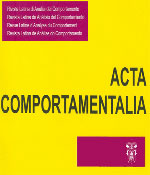Behavioral Variability: A structural taxonomy
DOI:
https://doi.org/10.32870/ac.v14i1.14530Keywords:
behavioral variability, frequency-dependent selection, random behavior, information theory.Abstract
Several empirical works have been devoted to study behavioral variability. However, the term “variability” does not contain a rigorous conceptual uniformity. In this paper structural taxonomy of variability is formulated by taking into account empirical studies that investigate behavioral variability. It is concluded that there are four conceptual groups which the term “variability” relates. The first group includes the studies that match variability with dispersion around a central tendency value. The second group includes the studies that match variability with distribution or distributive uniformity. The third group includes the studies that match variability with recency. The fourth group includes the studies that match variability with sequential dependence. We note, however, that different variables denoting dispersion, distribution, recency or sequential dependence can be identified sometimes at a single empirical work. Taking into account this fact, we developed a classification of dependent variables. We also developed a clustering of the empirical studies that have similar methodological characteristics. The four conceptual groups guided the classification of the dependent variables. Methological characteristics, on the other hand, guided the classification of the empirical studies. We note that empirical studies can be assigned to one of four different groups: the first group includes the studies that used two or more manipulanda set at different locations and chose dependent variables measuring distribution, distributive uniformity or dispersion. The second group includes the studies that behavioral variability using mazes and chose dependent variables measuring distribute uniformity or dispersion. The third group includes the studies that utilized sequential analysis of behavior and chose dependent variables measuring recency, distributive uniformity or randomness. The fourth group includes the studies works that studies behavioral variability using continuous variables and chose dependent variables measuring distributive uniformity or dispersion.
Downloads
Downloads
How to Cite
Issue
Section
License

<a rel="license" href="http://creativecommons.org/licenses/by-nc-sa/4.0/"><img alt="Licencia de Creative Commons" style="border-width:0" src="https://i.creativecommons.org/l/by-nc-sa/4.0/88x31.png" /></a><br />Este obra está bajo una <a rel="license" href="http://creativecommons.org/licenses/by-nc-sa/4.0/">licencia de Creative Commons Reconocimiento-NoComercial-CompartirIgual 4.0 Internacional</a>.






